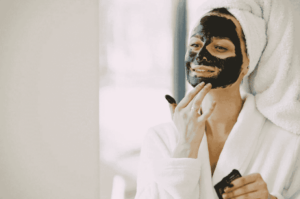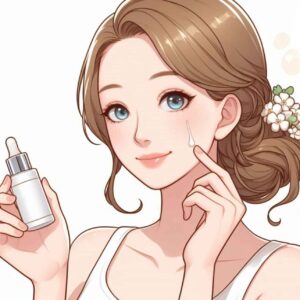Welcome Blessings!
(Tap 🔽 to see more topics!)


Skin type isn’t just a label. It’s the starting point for your skin’s happy place. You know that feeling when you see someone with that effortless glow? It’s not about expensive potions or complicated rituals… it’s about understanding what your skin truly needs. Your skin speaks its language, and this article is here to translate. Like how your favorite jeans fit differently over time, your skin changes as you age. Those teenage years might mean battling shine, while later on, it’s more about keeping things hydrated and smooth.
Everyone has been there, staring at a shelf full of products and wondering, ‘Where do I even start?’ It’s easy to get lost in the noise, but finding your perfect routine doesn’t have to be a headache. Whether you’re dealing with that stubborn, oily T-zone or trying to soothe dry, sensitive patches, there’s a way to make it work. This article discusses the five common skin types and how to tweak your skincare as you move through each decade.

The foundation of any skincare routine begins with knowing your skin type. It is like choosing the perfect pair of shoes. What works for one person might not work for you. There are five main skin types and understanding which category your skin falls into will help you pick products that best suit your needs.
1. Normal Skin
Normal skin is the equivalent of that effortlessly chic friend who never seems to break a sweat. It’s well-balanced, with no visible blemishes or irritation. It’s neither too oily nor too dry. The challenge here is maintaining that balance! Normal skin can tolerate most products, but it still requires gentle cleansing, moisturizing, and daily sunscreen to keep things in check.
2. Oily Skin
If your skin tends to shine too much by midday or you notice enlarged pores and frequent breakouts, you might have oily skin. Oily skin is like a garden that thrives with the proper care but can quickly get out of hand without it. If not controlled, your skin produces excess sebum, clogged pores, and acne. But don’t worry, it’s not a lost cause! The goal is to balance out the oil production, keep breakouts at bay, and prevent excess shine.
3. Dry Skin
Dry skin can feel like a thirsty sponge that’s craving moisture. It often feels tight, rough, and even flaky. When you have dry skin, you may also notice redness or irritation. While it might look dull, dry skin can be restored with the right ingredients. The key here is hydration, hydration, hydration, folks! Dry skin needs products that restore moisture, soothe irritation, and protect the skin’s barrier.
4. Combination Skin
Imagine treating two different skin concerns simultaneously… that’s what combination skin is like. The T-zone (your forehead, nose, and chin) tends to be oily, while your cheeks may feel dry or sensitive. It’s like juggling two completely different personalities, but with the right products, it’s manageable. You’ll need a skincare routine that addresses oily and dry patches without causing imbalance.
5. Sensitive/Acne-Prone Skin
Sensitive or acne-prone skin is a reactive friend who gets easily upset. Whether it’s from the weather, a harsh product, or stress, this skin type can react with redness, irritation, or acne. Hormonal changes, poor diet, or environmental factors can trigger breakouts. The goal is to use soothing, gentle products that target blemishes without irritating the skin.
To know your skin type, do this simple test at home:
1. First, give your face a clean slate. Wash with a gentle cleanser – nothing harsh – and pat it dry with a soft towel.
2. Now, wait. Leave your face alone for about an hour. No products, no touching.
3. It’s time to take a look. Go to a mirror and observe how your skin feels and looks.
4. See the results:
It’s really that simple. This little test is a great way to understand what your skin needs.
Like how your skin type shapes your skincare journey, your age also plays a significant role. As we age, our skin undergoes natural changes, and what worked for you in your 20s may not be as effective when you hit your 40s. Understanding how your skin’s needs evolve is key to crafting a skincare routine that works with your skin, not against it.
1. Teenage Years: Keeping It Simple
Ah, the teenage years- the golden age of acne and hormonal changes. During this time, your skin tends to be oilier and more prone to breakouts due to fluctuating hormones. But it’s essential to keep your routine simple. Focus on the basics: gentle cleansing, oil-free moisturizing, and sun protection. Don’t overcomplicate things with harsh treatments. You aim to keep your skin clean and calm and manage breakouts without drying it out.
Morning: Use a mild cleanser that targets acne and helps balance oil production.
Night: Follow up with a soothing acne treatment or serum and finish with a lightweight moisturizer. Always apply sunscreen in the morning; don’t skip this step!
2. The 20s: Prevention Is Key
Your skin is still youthful and resilient in your 20s, but you may start noticing the first signs of aging, like fine lines or dark spots. It is the perfect time to start focusing on prevention. Think of your 20s as the “prevention stage.” Now is the time to incorporate antioxidants, vitamin C, and a retinol-based product to begin addressing any early signs of aging.
Morning: Cleanse, apply a vitamin C serum for brightness, and finish with a light SPF.
Night: Treat with a hydrating serum and a gentle moisturizer with antioxidants and hydrating ingredients like hyaluronic acid.
3. The 30s: Hydration and Repair
In your 30s, you might notice your skin losing some elasticity. Collagen production begins to slow down, and you may see more noticeable fine lines or sagging skin. This is where your skincare routine needs to get more targeted—now, it’s all about hydration, repair, and boosting collagen. Ingredients like peptides, hyaluronic acid, and retinoids can help restore your skin’s youthful plumpness and smoothness.
Morning: Cleanse, treat with a hydrating serum, and use an SPF of at least 30.
Night: Use a retinol treatment (about twice a week) to encourage cell turnover, followed by a nourishing moisturizer that contains peptides or ceramides.
4. The 40s: Strengthening and Protection
By your 40s, your skin is starting to feel the effects of time more visibly. It becomes thinner, drier, and more prone to environmental damage. At this stage, it’s essential to strengthen your skin’s barrier and keep it hydrated. Look for products that contain ceramides, niacinamide, and retinoids, which help to rebuild the skin’s protective barrier and improve skin texture.
Morning: Cleanse with a gentle cream cleanser, then use a serum with niacinamide to strengthen the skin. Follow with SPF.
Night: Cleanse, treat with a retinoid to support cell turnover, and apply a rich moisturizer with hydrating oils like jojoba or argan oil.
5. 50s and Beyond: Nourishing and Restoring
Your skin becomes more fragile in your 50s and beyond, and you may notice increased dryness, sagging, or even redness. The key to skincare at this age is nourishment, restoration, and soothing. Products with growth factors, stem cells, and phytoestrogens can help replenish the skin’s density and vitality. Don’t forget to protect your skin from the sun and shield it from environmental stressors.
Morning: Use a gentle cleanser, apply a serum with growth factors or stem cells, and finish with an SPF of at least 30.
Night: Treat with a rich, hydrating cream containing peptides or stem cells and moisturize deeply.

Next, is to know your routine. Your skincare routine should consist of three basic steps: cleansing, treating, and moisturizing. Some examples of skincare routines for different scenarios are:
a. Oily and acne-prone skin in your 20s:
Morning:
Night:
b. Dry and sensitive skin in your 40s:
Morning:
Night:
c. Mixed type and normal skin in your 30s:
Morning:
Night:

Bottom line? Good skin isn’t some far-off dream, no matter your age. Our skin’s journey is part of the ride. Remember, our skin’s like a story, changing chapters as we go. From those teenage bumps to the beautiful wisdom lines we earn later on, it’s all part of what makes us. The real magic here is not chasing some impossible idea of perfect skin. It’s about giving your skin what it needs when it needs it. Keep it easy, stay consistent, and listen to what your skin is telling you. It’s your body’s way of talking and deserves to be heard.
What’s your skin’s story? What’s the one thing you will change in your routine starting today? Please share your thoughts in the comments below, or even better, snap a pic of your favorite product and tag us! We’d love to see how you care for your amazing skin. Voila! Until next time!